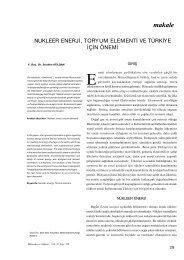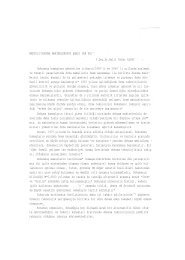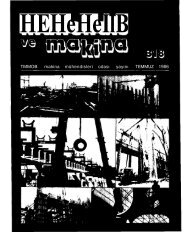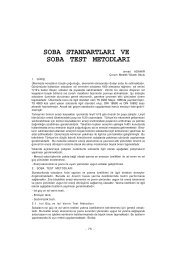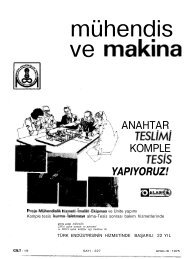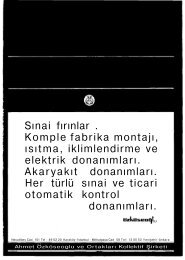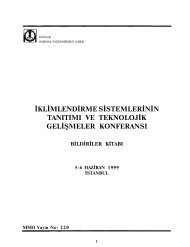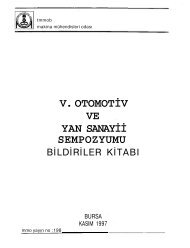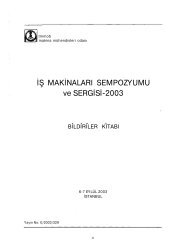advanced passive technology: a global standard for nuclear plant ...
advanced passive technology: a global standard for nuclear plant ...
advanced passive technology: a global standard for nuclear plant ...
You also want an ePaper? Increase the reach of your titles
YUMPU automatically turns print PDFs into web optimized ePapers that Google loves.
ADVANCED PASSIVE TECHNOLOGY: A GLOBAL STANDARD FOR<br />
NUCLEAR PLANT REQUIREMENTS<br />
Vince Novak<br />
Westinghouse Energy Systems Europe, Brussels<br />
ÖZET<br />
Westinghouse, Elektrik Enerjisi Araştırma Enstittüsü'nün ve A.B.D. Enerji BakınhgVnın insifiyatifi Özerine,<br />
1984 yılından beri, 600MW gücünde, iki döngülü, pasif sistemli bir santral olan AP600 santralını geliştirmektedir.<br />
Santralın ön tasarımı 1989 yılında tamamlanmıştır. AP600 santaralının Standart Güvenlik Analizi ve Olasılıklı<br />
Risk Analizi Raporları, 1992 yılında, tasarım onayı için, A.B.D.'nin lisanslama kuruluşu olan Atom enerjisi Komisyonu'na<br />
gönderilmiştir. Tasarım basitleştirme özelliği AP600 tasarımının anahtar stratejisini oluşturmaktadır. Basitleştirme<br />
adı verilen temel teknik kavram, basitleştirilmiş bir reaktör soğutucu sistemi, basitleştirilmiş santral sistemleri<br />
basitleştirilmiş bir santral yerleşim düzeni, azaltılmış ekipman sayısı, basitleştirilmiş işletme ve bakım<br />
özelliklerini ortaya çıkarmıştır.<br />
ABSTRACT<br />
Since 1984, Westinghouse has been developing AP600, a 600 MW, two-loop <strong>advanced</strong> <strong>passive</strong> <strong>plant</strong>, in<br />
response to an initiative established by the Electric Power Research Institute (EPRİ) and the U.S. Department of<br />
Energy (DOE). The preliminary design was compleved in 1989. AP600's Standard Safety Analysis and Probabilistic<br />
Risk analysis Reports were submitted to the U.S. Nuclear Regulatory Commission <strong>for</strong> design certification in<br />
1992. Design simplification is the key strategy behind the AP600. The basic technical concept of simplification<br />
has resulted in a simplified reactor coolant systems, simplified <strong>plant</strong> systems, a simplified <strong>plant</strong> arrangement, reduced<br />
number of components, simplified operation and maintenance.<br />
INTRODUCTION<br />
I thank the chamber of mechanical engineers and the sponsors <strong>for</strong> the opportunity to address<br />
this <strong>for</strong>um. My presentation focuses on <strong>passive</strong> <strong>nuclear</strong> <strong>technology</strong> due to its increasing importance in<br />
dealing simultaneously with key challenges the indicatory is facing today :<br />
• To meet the continued growth in electricity demand, which is becoming critical in many parts<br />
of the world, including Turkey, as we learned during the first day of the conference.<br />
• To provide a source of energy that will meet those demands in an efficient and economical<br />
way.<br />
• To respond to the need <strong>for</strong> safety.<br />
• And to respect concern <strong>for</strong> the environment and a <strong>global</strong> need <strong>for</strong> conservation.<br />
WESTiNGHOUSE POWER PLANT PORTFOLIO<br />
Westinghouse offers a power <strong>plant</strong> portfolio that includes pressurised water reactors (PWRs)<br />
with active safety systems ready <strong>for</strong> todays power needs, as well as innovative PWR designs with<br />
<strong>passive</strong> or natural safety systems to meet the energy demands of the future at! over the world.<br />
The APWR 1300 Development Program was started in 1978 by a Westinghouse team assigned<br />
to develop a state-of-the-art 1300 megawatt (net) four-loop <strong>plant</strong> <strong>for</strong> the 1990s that would offer substantial<br />
improvements in safety and generating costs, In 1981, the concept was proposed to interested<br />
parties in Japan, who agreed to share in the funding of a joint Westinghouse/MHI engineering program<br />
to pursue the detailed design and testing. To date, more than $200 million (U.S. dollars) have been invested<br />
in this program. Much of this evolutionary design is being put to use currently in England at Sizewell<br />
B, a <strong>plant</strong> project in which Westinghouse is actively involved.<br />
The objective of <strong>advanced</strong> simplified designs got its start in the APWR 1300 Development Program,<br />
and was further refined in the APWR 1000, and eventually the Advanced Passive (AP) <strong>plant</strong> series.<br />
115
AP600 PROGRAM MILESTONES<br />
Since 1984, Westinghouse has been developing AP600, a 600 megawatt, two-loop <strong>advanced</strong><br />
<strong>passive</strong> <strong>plant</strong>, in response to an initiative established by the Electric Power Research Institute (EPRİ)<br />
and the U.S. Department of Energy (DOE). The preliminary design was completed in 1989, and in<br />
1990 Westinghouse received contracts from EPRİ and DOE <strong>for</strong> a $120 million program <strong>for</strong> detailed design<br />
and design certification.<br />
AP600's Standard Safety Analysis and Probabilistic Risk Analysis Reports were submitted to<br />
the U.S. Nuclear Regulatory Commission <strong>for</strong> design certification in 1992. Another significant milestone<br />
was reached late last year when Westinghouse also received a first-of-a-kind engineering award <strong>for</strong><br />
$158 million from a team of U.S. utilities which comprise the Advanced Reactor Corporation.<br />
Both events will be discussed later.<br />
SAFE, PROVEN AND SIMPLE<br />
Design simplification is the key driving <strong>for</strong>ce - or strategy ~ behind the AP600. It is crucial that<br />
the new generation of <strong>nuclear</strong> <strong>plant</strong>s be easier and less expensive not only to build - but also to operate<br />
and maintain. The basic technical concept of simplification has resulted in a simplified reactor coolant<br />
system, simplified <strong>plant</strong> systems, a simplified <strong>plant</strong> arrangement, reduced number of components,<br />
simplified operation and maintenance.<br />
The AP600 has an overall streamlined design. The <strong>nuclear</strong> island alone uses 50 percent fewer<br />
valves, 80 percent less pipe, 70 percent less control cable, 35 percent fewer pumps, and 45 percent<br />
less seismic building volume than conventional <strong>nuclear</strong> reactors. Advanced microprocessor-based instrumentation<br />
and control systems also simplify and improve <strong>plant</strong> operation and maintenance. Other<br />
I&C features that enhance the safety and reliability of the <strong>plant</strong> are digital, multiplexed controls, built-in<br />
self-diagnostics, train separation, and equipment monitoring.<br />
AP600 I&C architecture is based on current W distributed microprocessor <strong>technology</strong>. The verification<br />
and validation has been reviewed by several regulatory bodies including US NRC and UK Nil.<br />
Eagle 21 process protection has been installed and is operating in Zion, Turkey point, Sequojah and<br />
South Texas Plants in US. The comprehensive "ANIS" in<strong>for</strong>mation system based on Westinghouse's<br />
WDPF family including "AWARE", <strong>advanced</strong> alarm management system and Beacon, <strong>advanced</strong> core<br />
monitoring system is being implemented in Beznau Plants in Switzerland. The integrated protection<br />
system and control system are ready to support hot functional test and core load of Sizewell B station,<br />
I mentioned be<strong>for</strong>e. An overall I&C including protection, redundant, BOP and Turbine control systems,<br />
in<strong>for</strong>mation system and <strong>advanced</strong> control room are being designed <strong>for</strong> Temelin Units 1 and 2, WER<br />
1000 <strong>plant</strong>s under construction in Czech Republic, I&C is not an exception. AP600 program strictly follows<br />
the policy on utilisation of proven structures, systems, components, designs and analyses. Let<br />
me just name several examples where principles of simplification and utilisation of proven technologies<br />
are best illustrated :<br />
The low-power density core consists of 145 fuel rod assemblies arranged in a <strong>standard</strong> display.<br />
This design is based on well-developed fuel <strong>technology</strong> using a low enrichment of uranium 235. A reference<br />
fuel cycle of 18 months has been selected to enhance availability, with an extension to 24<br />
months as an option.<br />
The core is surrounded by a stainless steel/water neutron radial reflector which reduces neutron<br />
leakage, with related reductions in enrichment and fuel cycle cost. The reactor internals are of essentially<br />
conventional design, so no new manufacturing development is required.<br />
The steam generators are Model Delta 75, based on Model F <strong>technology</strong>, a proven design with<br />
84 units in commercial operation. Model F uses Inconel 690 tubing proven to be superior to either 600<br />
or 800 alloys. The canned motor reactor coolant pumps have a high history of reliability, as well as low<br />
maintenance and greater tolerance <strong>for</strong> off-normal conditions.<br />
The integrated head package combines several separate components in one structure to simplify<br />
refuelling the reactor.<br />
116
Natural Safety systems<br />
The AP600 <strong>passive</strong> safety systems provide a simple method <strong>for</strong> meeting the same basic PWR<br />
safety functions which traditionally were provided by active safety systems. Principal safety functions -<br />
- primary coolant inventory control, reactivity control, reactor residual heat removal, and fission product<br />
containment -- are met with safety systems designed to use natural driving <strong>for</strong>ces, rather than rotating<br />
active equipment.<br />
These natural <strong>for</strong>ces include gravity injection and nitrogen pressurised accumulators <strong>for</strong> primary<br />
coolant inventory control... a natural circulation heat exchange loop <strong>for</strong> reactor residual heat removal<br />
. . . and evaporative cooling from outside the containment vessel to prevent radioactive leaks. The<br />
simplicity of these natural, <strong>passive</strong> safety systems enhances the defense-in-depth approach to <strong>plant</strong><br />
safety.<br />
Modularization, design processes, and economic benefits.<br />
My point about the economic benefits of the AP600 have to include a mention of modularization.<br />
Unique techniques from modular shipbuilding and construction will allow much of the AP600 to be prefabricated<br />
in modules. Factory préfabrication enhances quality, increases worker productivity, and reduces<br />
capital costs. Modules will be shipped to the site, joined together into larger modules, and inserted<br />
into preconstructured areas of the <strong>plant</strong>.<br />
Modular building methods <strong>for</strong> field construction also allow many areas of the <strong>plant</strong> to be built<br />
concurrently. Thanks to this approach, other simplifications, and bulk quantity reductions, the AP600<br />
can be constructed in three years from pouring the first concrete to fuel load.<br />
In addition to construction, the goals of simplification, modularization, and natural safety<br />
systems also pay off in operation and maintenance. Projected operation and maintenance costs are<br />
nearly 25 percent lower than the current industry average. O&M costs are kept down as the equipment<br />
most subject to regulation is eliminated. We are convinced that major savings can be achieved through<br />
the use of reduced hardware, easy access, historically reliable and redundant components.and<br />
lower fuel costs.<br />
AP600 CAN be economically competitive with other means of power generation.<br />
THE AP600 TEAM<br />
Westinghouse designed the first commercial <strong>nuclear</strong> power <strong>plant</strong> more than 30 years ago and<br />
has been the leader in continued development ever since. More than half the world's <strong>nuclear</strong> electricity<br />
is produced by reactors built to the Westinghouse design.<br />
Our expert AP600 Project Team reflects this tradition and experience, but also embraces the talents<br />
and historic accomplishments of several other firms which have joined with us in this endeavour.<br />
Among the prestigious names are Avondale Industries, Bechtel Power Corporation, Bums & Roe, CBI<br />
Services, MK-Ferguson, Robert L. Cloud & Associates, and Southern Electric International. As I mentioned<br />
be<strong>for</strong>e, AP600 is also indebted to the pioneering ideas and joint ef<strong>for</strong>ts of the team of engineers<br />
who worked on the APWR design <strong>for</strong> Westinghouse and Mitsubishi.<br />
Also, the AP600 has been influenced since its conception by the participation of the U.S. Department<br />
of Energy, which considers the AP600 an integral part of America's national energy strategy;<br />
the Electric Power Research Institute, one of the <strong>nuclear</strong> industry's premier institutions, and two industry<br />
teams from the U.S. ~ the Advanced Reactor Corporation and the Advanced Light Water Reactor<br />
Steering Committee.<br />
AP600 IS INTERNATIONAL<br />
Another invaluable asset to Westinghouse's <strong>passive</strong> <strong>plant</strong> program is international participation.<br />
This overhead shows a long list, which you can see spans the globe from Spain, contributing to module<br />
analysis and design. . . to Poland participating in overall <strong>plant</strong> engineering. . . to Italy, heavily involved<br />
in component engineering and many tests and analyses ... to Indonesia, per<strong>for</strong>ming <strong>plant</strong> layout<br />
117
and detailed design work on balance-of-<strong>plant</strong>... to Japan supporting <strong>plant</strong> layout ef<strong>for</strong>ts, engineering,<br />
and I&C. The enthusiastic joint ef<strong>for</strong>ts of engineers from these and many other nations ensures the suitability<br />
of AP600 to meet worldwide generation needs. Discussions is ongoing with number of other<br />
countries. All I can say is welcome Turkey.<br />
STANDARDISATION AND LICENSING<br />
AP600's first-of-a-kind engineering program is the key to a <strong>standard</strong>ised <strong>plant</strong> design which allows<br />
the faster construction schedule and steeper learning curves than custom-engineered <strong>plant</strong>s.<br />
Plant <strong>standard</strong>isation is the enhancement on which quality assurance, cost assurance, and construction<br />
schedule assurance rest. It is also the key to the solution of licensing issues that Westinghouse has<br />
worked so hard to address, especially in the United States.<br />
The major re<strong>for</strong>m of licensing process in the U.S., begun in 1989, called <strong>for</strong> the certification of a<br />
<strong>nuclear</strong> power <strong>plant</strong> design, rather than the licensing of a single <strong>plant</strong>. Rather than the complex and<br />
unpredictable licensing process oriented to customised "one-of-a-kind" <strong>plant</strong>s, certified <strong>standard</strong> design<br />
<strong>plant</strong>s can be issued combination construction permit AND operating licenses when combined<br />
with a pre-approved site.<br />
This process allows <strong>for</strong> early public participation, required worldwide in varying degrees, as well<br />
as the site permitting process and the combined license issuance. This method avoids the kinds of<br />
project delays that can have an adverse impact on the budget.<br />
In the U.S., the Nuclear Power Oversight Committee, a council of industry executives, has planned<br />
a strategy <strong>for</strong> <strong>advanced</strong> <strong>passive</strong> <strong>plant</strong> certification in the U.S. It is a multi-track licensing process.<br />
Westinghouse and other industry leaders are now working with the U.S. Nuclear Regulatory Commission<br />
to agree on the schedule.<br />
AP600 LICENSING STATUS<br />
A current status report on where AP600 licensing stands in the U.S. right now is shown in this<br />
list. The first step in this process was submittal of the <strong>standard</strong> safety analysis report which was submitted<br />
in June 1992. It addresses topics the NRC will be required to review prior to approving the<br />
AP600 design. A Probabilistic Risk Assessment was submitted at the same time. It has also been<br />
used by the AP600 engineers as a design tool.<br />
We are now in the process of finishing all the inspections, tests, analysis, and acceptance criteria<br />
that will be submitted. Our licensing application is complete and of the 846 questions generated by<br />
review of the SSAR, 744 responses have been provided as of September this year. In the meantime,<br />
there have been more questions and answers. The regulatory treatment of non-safety systems has<br />
been agreed upon. Also, a significant amount of the required testing has been completed and integral<br />
systems tests are about to start.<br />
The NRC Safety Evaluation Report will be the final review of the design certification. Its issuance<br />
is the last step be<strong>for</strong>e design certification of the AP600 design as a <strong>standard</strong>ised <strong>plant</strong> in the U.S.<br />
ADVANCED TECHNOLOGY PASSIVE TECHNOLOGY FOR<br />
THE WORLD AND TURKEY<br />
While the AP600 is looked upon a centrepiece of the <strong>nuclear</strong> industry in the U.S., there is also<br />
much interest in <strong>advanced</strong> <strong>passive</strong> <strong>technology</strong> in other countries. One important point I would like to<br />
make specifically to this audience is the value of <strong>advanced</strong> <strong>passive</strong> <strong>technology</strong> to a nation which<br />
doesn't currently have a <strong>nuclear</strong> <strong>plant</strong>.<br />
I've talked to quite a bit about the benefits of <strong>standard</strong>isation and pre-approved licensing from<br />
the technical and economic standpoints, but let's also consider another one. A country such as Turkey<br />
- where now there is no <strong>nuclear</strong> <strong>plant</strong> -- has the opportunity to start a <strong>nuclear</strong> program building on the<br />
lessons learned from countries with decades of experience in both the technical and strategic issues.<br />
118
Advanced <strong>passive</strong> <strong>technology</strong> combines the best of what we know works with the means to<br />
address the needs of the new utility environment. In other words, AP600 is a new order of business.<br />
That will be a breath of fresh air in countries where the <strong>nuclear</strong> industry has been bogged down by historic<br />
issues. But it could be an energy revolution in nations which are taking the first step toward the<br />
unique benefits which <strong>nuclear</strong> energy can provide.<br />
Each country has to <strong>for</strong>ge its own energy policy in response to the unique issues technological,<br />
economic, and political issues it faces. But when and where a nation's energy policy can include <strong>nuclear</strong><br />
power, a new generation of <strong>advanced</strong> <strong>passive</strong> reactors is ready.<br />
The AP600 is an example of a total <strong>plant</strong> design that is simpler, safer, and quicker to build.<br />
Westinghouse advocates an <strong>advanced</strong> reactor portfolio that is <strong>standard</strong>ised <strong>for</strong> design and beyond...<br />
is economically competitive... and is built to firm cost and schedule.<br />
By making <strong>advanced</strong> <strong>passive</strong> <strong>nuclear</strong> <strong>technology</strong> safe, reliable, and cost effective, Westinghouse<br />
can meet the world's need <strong>for</strong> electricity.<br />
119



